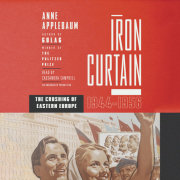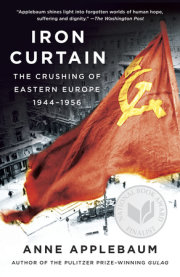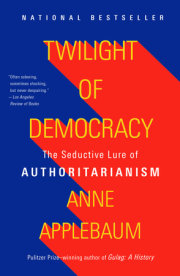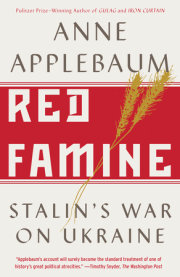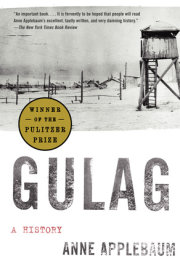Chapter 1
Zero Hour
The mad orgy of ruins, entangled wires, twisted corpses, dead horses, overturned parts of blown-up bridges, bloody hoofs which had been torn off horses, broken guns, scattered ammunition, chamber pots, rusted washbasins, pieces of straw and entrails of horses floating in muddy pools mixed with blood, cameras, wrecked cars and tank parts: They all bear witness to the awful suffering of a city . . .
—Tamás Lossonczy, Budapest, 1945
How can one find words to convey truthfully and accurately the picture of a great capital destroyed almost beyond recognition; of a once almighty nation that ceased to exist; of a conquering people who were so brutally arrogant and so blindingly sure of their mission as a master race . . . whom you now see poking about their ruins, broken, dazed, shivering, hungry human beings without will or purpose or direction.
—William Shirer, Berlin, 1945
It seemed to me that I was walking on corpses, that at any moment I would step into a pool of blood.
—Janina Godycka-Cwirko, Warsaw, 1945
Explosions echoed throughout the night, and artillery fire could be heard throughout the day. Across Eastern Europe, the noise of falling bombs, rattling machine guns, rolling tanks, churning engines, and burning buildings heralded the approach of the Red Army. As the front line drew closer, the ground shook, the walls shivered, the children screamed. And then it stopped.
The end of the war, wherever and whenever it came, brought with it an abrupt and eerie silence. “The night was far too quiet,” wrote one anonymous chronicler of the war’s end in Berlin. On the morning of April 27, 1945, she went out of her front door and saw no one: “Not a civilian in sight. The Russians have the streets entirely to themselves. But under every building people are whispering, quaking. Who could ever imagine such a world, hidden here, so frightened, right in the middle of the big city?”
On the morning of February 12, 1945, the day the siege of the city came to an end, a Hungarian civil servant heard the same silence on the streets of Budapest. “I got to the Castle District, not a soul anywhere. I walked along Werbõczy Street. Nothing but bodies and ruins, supply carts, and drays . . . I got to Szentháromság Square and decided to look in at the Council in case I found somebody there. Deserted. Everything turned upside down and not a soul . . .”
Even Warsaw, a city already destroyed by the time the war ended—the Nazi occupiers had razed it to the ground following the uprising in the autumn—grew silent when the German army finally retreated on January 16, 1945. W³adys³aw Szpilman, one of a tiny handful of people hiding in the ruins of the city, heard the change. “Silence fell,” he wrote in his memoir, The Pianist, “a silence such as even Warsaw, a dead city for the last three months, had not known before. I could not even hear the steps of the guards outside the building. I couldn’t understand it.” The following morning, the silence was broken by a “loud and resonant noise, the last sound I expected”: the Red Army had arrived, and loudspeakers were broadcasting, in Polish, the news of the liberation of the city.
This was the moment sometimes called zero hour, Stunde Null: the end of the war, the retreat of Germany, the arrival of the Soviet Union, the moment the fighting ended and life started up again. Most histories of the communist takeover of Eastern Europe begin at precisely this moment, and logically so. To those who lived through this change of power, zero hour felt like a turning point: something very concrete came to an end, and something very new began. From now on, many people said to themselves, everything would be different. And it was.
Yet although it is logical to begin any history of the communist takeover in Eastern Europe with the end of the war, it is in some ways deeply misleading. The people of the region were not faced with a blank slate in 1944 or 1945, after all, and they were not themselves starting from scratch. Nor did they emerge from nowhere, with no previous experiences, ready to start afresh. Instead, they climbed out of the basements of their destroyed homes, or walked out of the forests where they had been living as partisans, or slipped away from the labor camp where they had been imprisoned, if they were healthy enough, and embarked upon long, complicated journeys back to their homelands. Not all of them even stopped fighting when the Germans surrendered.
As they crawled out of the ruins, they saw not virgin territory but destruction. “The war ended the way a passage through a tunnel ends,” wrote the Czech memoirist Heda Kovály. “From far away you could see the light ahead, a gleam that kept growing, and its brilliance seemed ever more dazzling to you huddled there in the dark the longer it took to reach it. But when at last the train burst out in the glorious sunshine, all you saw was a wasteland full of weeds and stones, and a heap of garbage.”
Photographs from across Eastern Europe at that time show scenes from an apocalypse. Flattened cities, acres of rubble, burned villages, and smoking, charred ruins where houses used to be. Tangles of barbed wire, the remains of concentration camps, labor camps, POW camps; barren fields, pockmarked by tank tracks, with no sign of farming, husbandry, or life of any kind. In the recently destroyed cities, the air was suffused with the smell of corpses. “The descriptions I’ve read always use the phrase ‘sweetish odour,’ but that’s far too vague, completely inadequate,” wrote one German survivor. “The fumes are not so much an odour as something firmer, something thicker, a soupy vapor that collects in front of your face and nostrils, too mouldy and thick to breathe. It beats you back as if with fists.”
Provisional burial sites were everywhere, and people walked through the streets gingerly, as if traversing a cemetery. In due course exhumations began, as bodies were removed from courtyards and city parks to mass graves. Funerals and reburial ceremonies were frequent, though in Warsaw one was famously interrupted. In the summer of 1945, a funeral march was slowly wending its way through Warsaw when the black-clad mourners saw an extraordinary sight: “A living, red Warsaw tram,” the first to run through the city since the war’s end. “The pedestrians on the sidewalks stopped, others ran alongside the tram clapping and cheering loudly. Extraordinarily, the funeral march stopped too, the mourners accompanying the dead, captivated by the general mood, turned to the tram and began to clap too.”
This too was typical. At times a weird euphoria seemed to grip the survivors. It was a relief to be alive; sorrow was mixed with joy, and commerce, trade, and reconstruction began immediately, spontaneously. Warsaw in the summer of 1945 was a bustling hive of activity, Stefan Kisielewski wrote: “In the ruins of the streets, there’s commotion like never before. Trade—buzzing. Work—booming. Humor—everywhere. The mob, teeming life, flows through the streets, nobody would think that these are all victims of a massive disaster, people who have scarcely recovered from a catastrophe, or that they are living in extreme, inhuman conditions . . .” Sándor Márai described Budapest in one of his novels at this same period:
Whatever remained of the city, of society, sprang to life with such passion, fury, and sheer willpower, with such strength and stamina and cunning, it seemed as if nothing had happened . . . out on the boulevard there were suddenly stalls in gateways, selling all kinds of nice food and luxury items: clothes, shoes, everything you could imagine, not to mention gold napoleons, morphine, and pork lard. The Jews who remained staggered from their yellow star houses and within a week or two you could see them bargaining, surrounded as they were by the corpses of men and horses . . . People were quibbling over prices for warm British cloth, French perfumes, Dutch brandy, and Swiss watches among the rubble . . .
This enthusiasm for work and renewal would last for many years. The British sociologist Arthur Marwick once speculated that the experience of national failure might have given the West Germans an incentive to rebuild, to regain a sense of national pride. The very scale of the national collapse, he argued, might have helped contribute to the postwar boom: having experienced economic and personal catastrophe, Germans readily threw themselves into reconstruction.14 But Germany, both East and West, was not alone in this drive to recover and to become “normal” again. Over and over, Poles and Hungarians in memoirs and conversations about the postwar period speak of how desperately they sought education, ordinary work, a life without constant violence and disruption. The communist parties were perfectly poised to take advantage of these yearnings for peace.
In any case, damage to property was easier to repair than the demographic damage in Eastern Europe, where the scale of violence had been higher than anything known on the western half of the continent. During the war, Eastern Europe had experienced the worst of both Stalin’s and Hitler’s ideological madness. By 1945, most of the territory between Poznañ in the west and Smolensk in the east had been occupied not once but twice, or even three times. Following the Molotov-Ribbentrop Pact of 1939, Hitler had invaded the region from the west, occupying western Poland. Stalin had invaded from the east, occupying eastern Poland, the Baltic States, and Bessarabia. In 1941, Hitler once again invaded these same territories from the west. In 1943, the tide turned again and the Red Army marched back through the same region once more, coming from the east.
By 1945, in other words, the lethal armies and vicious secret policemen of not one but two totalitarian states had marched back and forth across the region, each time bringing about profound ethnic and political changes. To take one example, the city of Lwów was occupied twice by the Red Army and once by the Wehrmacht. After the war ended it was called L’viv, not Lwów; it was no longer in eastern Poland but in the western part of Soviet Ukraine; and its Polish and Jewish prewar population had been murdered or deported and replaced by ethnic Ukrainians from the surrounding countryside.
Eastern Europe, along with Ukraine and the Baltic States, was also the site of most of the politically motivated killing in Europe. “Hitler and Stalin rose to power in Berlin and Moscow,” writes Timothy Snyder in Bloodlands, the definitive history of the mass killing of this period, “but their visions of transformation concerned above all the lands between.”15 Stalin and Hitler shared contempt for the very notion of national sovereignty for any of the nations of Eastern Europe, and they jointly strove to eliminate their elites. The Germans considered Slavs to be subhumans, ranked not much higher than Jews, and in the lands between Sachsenhausen and Babi Yar they thought nothing of ordering arbitrary street killings, mass public executions, or the burning of whole villages in revenge for one dead Nazi. The Soviet Union, meanwhile, considered its western neighbors to be capitalist and anti-Soviet strongholds whose very existence posed a challenge to the USSR. In 1939, and again in 1944 and 1945, the Red Army and the NKVD would arrest not only Nazis and collaborators in their newly conquered territories but anyone who might theoretically oppose Soviet administration: social democrats, antifascists, businessmen, bankers, and merchants—often the same people targeted by the Nazis. Although there were civilian casualties in Western Europe, as well as incidents of theft, misbehavior, and abuse perpetrated by the British and American armies, for the most part the Anglo-Saxon troops were trying to kill Nazis, not potential leaders of the liberated nations. And, for the most part, they treated the resistance leaders with respect and not suspicion.
The East is also where the Nazis had most vigorously pursued the Holocaust, where they set up the vast majority of ghettoes, concentration camps, and killing fields. Snyder notes that Jews accounted for less than 1 percent of the German population when Hitler came to power in 1933, and many of those managed to flee. Hitler’s vision of a “Jew-free” Europe could only be realized when the Wehrmacht invaded Poland, Czechoslovakia, Belarus, Ukraine, and the Baltic States, and eventually Hungary and the Balkans, which is where most of the Jews of Europe actually lived. Of the 5.4 million Jews who died in the Holocaust, the vast majority were from Eastern Europe. Most of the rest were taken to the region to be murdered. The scorn the Nazis held for all Eastern Europeans was closely related to their decision to take the Jews from all over Europe to the East for execution. There, in a land of subhumans, it was possible to do inhuman things.
Above all, Eastern Europe is where Nazism and Soviet communism clashed. Although they began the war as allies, Hitler had always wanted to fight a war of destruction against the USSR, and after Hitler’s invasion Stalin promised the same. The battles between the Red Army and the Wehrmacht were therefore fiercer and bloodier in the east than those that took place further west. German soldiers truly feared the Bolshevik “hordes,” about whom they had heard many terrible stories, and toward the end of the war they fought them with particular desperation. Their scorn for civilians was especially profound, respect for local culture and infrastructure nonexistent. A German general defied Hitler’s orders and left Paris standing out of sentimental respect for the city, but other German generals burned Warsaw to the ground and destroyed much of Budapest without thinking about it. Western air forces were not especially concerned about the ancient architecture of this region either: Allied bombers contributed to the toll of death and destruction too, conducting aerial bombardment not only of Berlin and Dresden but also of Danzig and Königsberg, Gdañsk and Kaliniñgrad—among many other places.
As the eastern front moved into Germany itself, fighting only intensified. The Red Army focused on its drive to Berlin with something approaching obsession. From early on in the war, Soviet soldiers bade farewell to one another with the cry, “See you in Berlin.” Stalin was desperate to reach the city before the other Allies got there. His commanders understood this, and so did their American counterparts. General Eisenhower, knowing full well that the Germans would fight to the death in Berlin, wanted to save American lives and decided to let Stalin take the city. Churchill argued against this policy: “If they [the Russians] . . . take Berlin, will not their impression that they have been the overwhelming contributor to our common victory be unduly imprinted in their minds, and may this not lead them into a mood which will raise grave and formidable difficulties in the future?” But the American general’s caution won out, and the Americans and British advanced slowly to the east—General George C. Marshall having once declared he would be “loath to hazard American lives for purely political purposes,” and Field Marshal Sir Alan Brooke arguing that “the advance into the country really had to coincide to a certain extent with what our final boundaries would be.”18 Meanwhile, the Red Army charged directly toward the German capital, leaving a trail of destruction in its wake.
Copyright © 2012 by Anne Applebaum. All rights reserved. No part of this excerpt may be reproduced or reprinted without permission in writing from the publisher.



